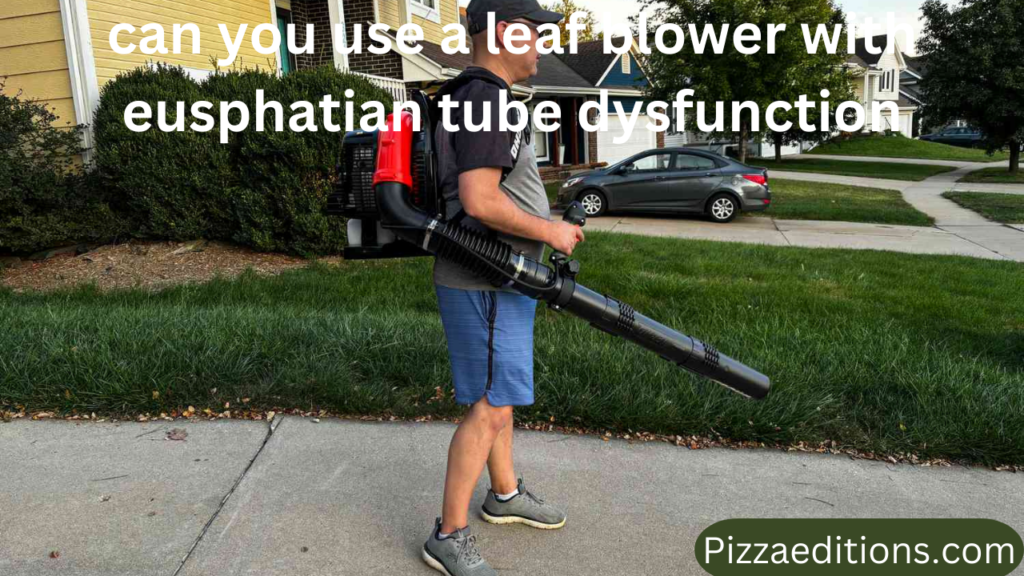Introduction
Eustachian Tube Dysfunction (ETD) is a condition that affects the small passageways connecting the middle ear to the back of the throat. It can cause discomfort, pressure buildup, and hearing difficulties. For individuals dealing with ETD, everyday activities that involve exposure to changes in air pressure, noise, and vibrations can be a cause for concern. One such activity is using a leaf blower. This article explores whether it is safe to use a leaf blower with Eustachian Tube Dysfunction, the potential risks, and necessary precautions.
Understanding Eustachian Tube Dysfunction
The Eustachian tubes help regulate pressure in the middle ear and drain fluids. When these tubes become blocked or do not function properly, it can result in symptoms such as:
- Ear pain or discomfort
- Muffled hearing
- A feeling of fullness in the ears
- Popping or clicking sounds
- Dizziness or balance issues
ETD can be triggered by allergies, colds, sinus infections, or even exposure to environmental irritants like dust and smoke. Activities that involve rapid changes in air pressure, loud noises, or strong vibrations can exacerbate ETD symptoms.
The Impact of Using a Leaf Blower on Eustachian Tube Dysfunction
Leaf blowers generate significant noise, strong airflow, and vibrations. These factors can contribute to worsening ETD symptoms in several ways:
1. Noise Exposure and Hearing Concerns
Leaf blowers produce noise levels ranging from 80 to 110 decibels (dB). Prolonged exposure to high-decibel noise can aggravate ear discomfort and potentially contribute to further hearing issues. Individuals with ETD are already susceptible to ear pressure imbalances, and exposure to loud sounds may worsen their symptoms.
2. Air Pressure Changes
Leaf blowers create powerful gusts of air, which can affect the surrounding environment, including air pressure changes around the ear. Rapid fluctuations in air pressure can make ETD symptoms worse, leading to increased discomfort, blocked ears, or dizziness.
3. Vibrations and Head Movements
The strong vibrations from holding and operating a leaf blower may transmit through the arms and head, potentially impacting the middle ear and aggravating ETD. Excessive vibrations could contribute to an increased sense of imbalance, particularly for those already experiencing dizziness due to ETD.
4. Exposure to Dust and Allergens
Leaf blowers stir up dust, pollen, and debris, which can enter the respiratory system and worsen sinus congestion. Since ETD is often linked to sinus issues and allergies, exposure to airborne particles may exacerbate symptoms, leading to prolonged discomfort and potential complications.
Precautions for Using a Leaf Blower with Eustachian Tube Dysfunction
If you must use a leaf blower despite having ETD, it is essential to take certain precautions to minimize risks and discomfort:
1. Wear Hearing Protection
To reduce noise exposure, consider using high-quality ear protection such as earmuffs or earplugs. Noise-canceling earmuffs rated at least 30 dB reduction can help prevent excessive noise from aggravating ETD symptoms.
2. Use a Low-Vibration Model
Some leaf blowers are designed with lower vibration levels. Opt for a model that minimizes hand and body vibration to prevent excessive transmission of movement that could worsen dizziness or balance issues.
3. Limit Usage Time
Avoid prolonged use of the leaf blower. Taking frequent breaks and limiting exposure can help prevent symptoms from worsening. If possible, use alternative methods like raking or using an electric blower with lower intensity.
4. Wear a Dust Mask
A high-quality dust mask or respirator can help reduce exposure to airborne particles, preventing allergens or irritants from worsening sinus congestion and ETD symptoms.
5. Maintain a Safe Posture
Keeping your head in a stable, neutral position while operating the leaf blower can reduce strain on the Eustachian tubes. Avoid excessive head tilting or rapid movements that may trigger dizziness.
6. Stay Hydrated and Manage Allergies
Drinking plenty of fluids and using saline nasal sprays can help keep the Eustachian tubes clear. If allergies contribute to your ETD, take antihistamines or decongestants as advised by your doctor before using a leaf blower.
7. Consider Alternative Yard Maintenance Methods
If using a leaf blower is too uncomfortable or triggers severe symptoms, consider alternative methods such as raking, using a leaf vacuum, or hiring assistance for yard maintenance.
When to Avoid Using a Leaf Blower Completely
There are circumstances where it may be best to avoid using a leaf blower altogether:
- Severe ETD Symptoms: If you are experiencing extreme ear pain, dizziness, or significant hearing issues, it is advisable to refrain from using a leaf blower until your symptoms improve.
- Recent Ear Infections or Sinus Issues: If you have an active infection or a cold that has worsened your ETD, exposure to additional irritants may prolong recovery.
- History of Noise Sensitivity or Hearing Loss: Individuals with existing hearing problems or extreme sensitivity to noise should consult a medical professional before using a loud device like a leaf blower.
Conclusion
So, can you use a leaf blower with Eustachian Tube Dysfunction? The answer depends on the severity of your condition and the precautions you take. While it is possible to operate a leaf blower with ETD, the risks of noise exposure, air pressure changes, vibrations, and allergens should not be ignored. Using protective measures such as hearing protection, limiting exposure time, and wearing a dust mask can help reduce potential complications. However, if symptoms persist or worsen, it may be best to avoid using a leaf blower and explore alternative yard maintenance options. If in doubt, consult with a healthcare provider to assess your condition and determine the safest course of action.
